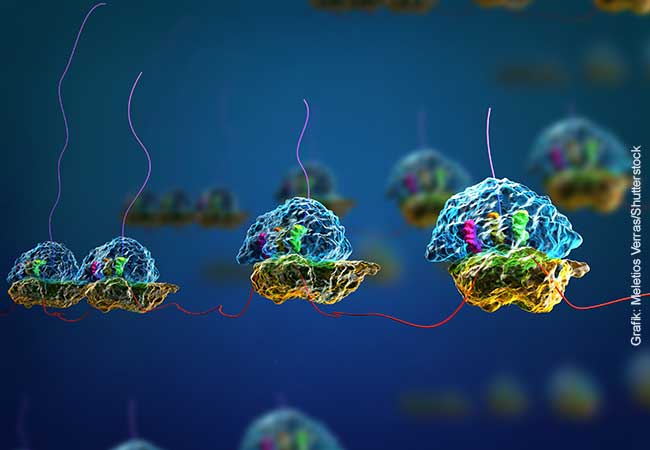
Chemical bonds within the eye-lens protein gamma-B crystallin hold the protein together and are therefore important for the function of the protein within the lens. Contrary to previous assumptions, some of these bonds, called disulphide bridges, are already formed simultaneously with the synthesis of the protein in the cell. This is what scientists at Goethe University Frankfurt, Max Planck Institute of Biophysics and the French Institute de Biologie Structurale in Grenoble have discovered.
The lens of the human eye gets its transparency and refractive power from the fact that certain proteins are densely packed in its cells. These are mainly crystallines. If this dense packing cannot be maintained, for example due to hereditary changes in the crystallines, the result is lens opacities, known as cataracts, which are the most common cause of vision loss worldwide.
In order for crystallins to be packed tightly in lens fibre cells, they must be folded stably and correctly. Protein folding already begins during the biosynthesis of proteins in the ribosomes, which are large protein complexes. Ribosomes help translate the genetic code into a sequence of amino acids. In the process, ribosomes form a protective tunnel around the new amino acid chain, which takes on three-dimensional structures with different elements such as helices or folded structures immediately after the tunnel’s formation. The gamma-B crystallines studied in Frankfurt and Grenoble also exhibit many bonds between two sulphur-containing amino acids, so-called disulphide bridges.
The production of these disulphide bridges is not easy for the cell, since biochemical conditions prevail in the cell environment that prevent or dissolve such disulphide bridges. In the finished gamma-B crystalline protein, the disulphide bridges are therefore shielded from the outside by other parts of the protein. However, as long as the protein is in the process of formation, this is not yet possible.
But because the ribosomal tunnel was considered too narrow, it was assumed – also on the basis of other studies – that the disulphide bridges of the gamma-B crystallins are formed only after the proteins have been completed. To test this assumption, the researchers from Frankfurt and Grenoble used genetically modified bacterial cells as a model system, stopped the synthesis of the gamma-B crystallins at different points in time and examined the intermediate products with mass spectrometric, nuclear magnetic resonance spectroscopic and electron microscopic methods, and supplemented these with theoretical simulation calculations. The result: The disulphide bridges are already formed on the not yet finished protein during the synthesis of the amino acid chain.
„We were thus able to show that disulphide bridges can already form in the ribosomal tunnel, which offers sufficient space for this and shields the disulphide bridges from the cellular milieu,“ says Prof. Harald Schwalbe from the Institute of Organic Chemistry and Chemical Biology at Goethe University. „Surprisingly, however, these are not the same disulphide bridges that are later present in the finished gamma-B crystallin. We conclude that at least some of the disulphide bridges are later dissolved again and linked differently. The reason for this probably lies in the optimal timing of protein production: the ‚preliminary‘ disulphide bridges accelerate the formation of the ‚final‘ disulphide bridges when the gamma-B crystallin is released from the ribosome.“
In further studies, the researchers now want to test whether the synthesis processes in the slightly different ribosomes of higher cells are similar to those in the bacterial model system.
Publication: Linda Schulte, Jiafei Mao, Julian Reitz, Sridhar Sreeramulu, Denis Kudlinzki, Victor-Valentin Hodirnau, Jakob Meier-Credo, Krishna Saxena, Florian Buhr, Julian D. Langer, Martin Blackledge, Achilleas S. Frangakis, Clemens Glaubitz, Harald Schwalbe: Cysteine oxidation and disulfide formation in the ribosomal exit tunnel. Nature Communications https://doi.org/10.1038/s41467-020-19372-x








